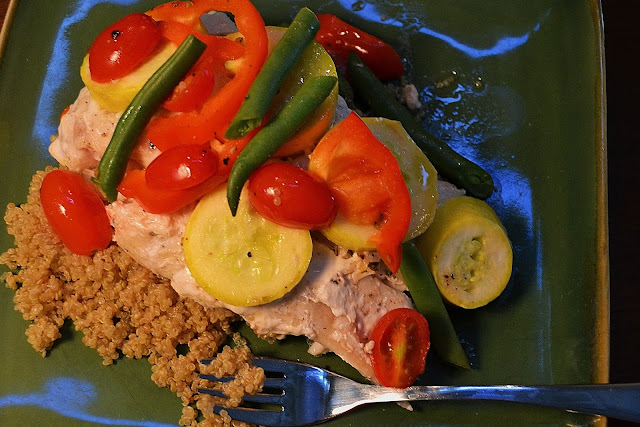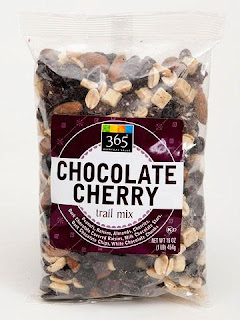Inevitably the snow-crusted trees yield to the warmth of the sun and the crocuses trust it is their time to shine. The changing of the season to new beginnings and renewal are the hallmarks of spring when we peel off our many layers, both literally and figuratively. For many of us this means renewing or adding in more physical activities, as well as airing out rugs, cleaning out gutters, uncovering patio furniture, and shedding heavy comforters for lighter cotton throws.
It's just as important to transition to lighter eating as our bodies naturally shift away from needing more calories in those colder months. Most of us easily gravitate towards foods that cool us like salads, smoothies and water-based fruits but there is one area that often gets neglected in this happy season of sun-soaked days: your kitchen pantry.
You've stocked it full of oatmeal, other grains, nuts, flours, beans, pasta sauces, and other holiday ingredients that got you through the seasons of baking, stews and hearty soups. It's the perfect time to assess what needs to stay, what can go to the back of the cupboard and what is lacking for healthy warm-weather meals and snacks.
Let the sun shine into your pantry with these 3 easy steps for what to keep, what to add in and I'll even link you to lighter recipe options for pantry items typically thought of only as comfort foods.
Step 1: Take everything out one shelf at a time. If, however, there is no organization to your pantry at all then take everything out!
Here is a peak at my dry good pantry:
The top shelf (not shown) is for my grains, pastas, dried beans, seaweeds. Just underneath are all my canned goods, jarred sauces and other jarred ingredients followed by a shelf for baking items like flours and natural sweeteners. The most accessible shelf is all snacks which allows easy access for my kids and the bottom shelf is where I store liquids, items too large to fit on other shelves, seasonal and overstock items (if they were on sale). *Are you curious to see what this whole foods mama stashes as healthy snacks? Skip over to my blog post to take a detailed peek at my family's favorite snacks that can always be found on this highly popular shelf in my pantry.
I have another pantry right beside this one which houses all my spices, vinegars, and oils that are not used on a regular basis (my everyday spices, oils, etc. are in drawers next to my stove top and oven) as well as all my tupperware, kids' lunch boxes and water bottles.
This is what works for me and is a general guide for you to follow as we all live our lives a little bit differently, have different kitchen and storage layouts. Only you will know what needs to be prioritized in the spaces that you have.
Don't forget to give all the shelves a good wipe! It's nice to have crumb- and goo-free shelves especially if this is a chore you'll complete 1-2 a year.
Step 2: As you empty each shelf assess which items are expired, stale or no longer of use to you. Pitch them! Return the good items back on your shelf and be as organized (or not) as you want; i.e., alphabetize your spices, sweet canned goods all together, canned beans all together, dried beans on one side, pastas on the other, etc.
Here is a quick guide to how long you can store items typically found in a kitchen pantry or cabinet:
Spices:
- Whole Spices and Herbs: 1-2 years
- Whole Seeds and Roots: 3 years
- Ground Spices and Herbs: 1 year
- Ground Roots: (e.g. ginger) 1-2 years
Nuts, Seeds and Oils:
- Oils: up to 18 months unopened, 1-6 months opened in cool, dark conditions
- Dried Beans: 1-2 years unopened
- Canned Beans: 2-3 years
- Raw Nuts (without shell): 4 months
- Raw Nuts (with shell): 6 months
- Peanut and Nut Butter: 6-9 months unopened, 2-3 months opened (shelf stable varieties)
- Raw Seeds (without shell): 2-3 months
- Roasted Seeds (without shell): 3-4 months
- Roasted Seeds (with shell): 4-5 months
Flours and Grains:
- Barley (pearled):12 months
- Brown Rice: 6 months
- White Rice: 2-4 years
- Wild Rice: 2- years
- All-Purpose Flour: 8 months
- Bread Flour: 3-6 months
- Brown Rice Flour: Store in the refrigerator due to the high oil content.
- Corn Flour: 1 year
- Flaxseed: 2-3 months
- Spelt Flour:4-5 months
- White Rice Flour: indefinitely when properly stored
- Whole Wheat Flour: 2-3 months in a cool place, 6 months in the refrigerator
Sauces, Condiments and Other Pantry:
- Baking Soda: 18-24 months
- Baking Powder: 6 months
- Dried Bread Crumbs: 6 months
- Buttermilk Powder: 2 years
- Oatmeal, Grits, and Hot Cereals: 1 year
- Chocolate: 6-12 months unopened and stored in a cool, dry place
- Corn Meal: 6-12 months
- Corn Starch: 18 months
- Dried Fruits: 6-12 months
- Jam and Jelly: 1 year unopened
- Ketchup: 1 year unopened
- Sweetened Condensed Milk: 2-3 years
- Evaporated Milk: 1-2 years
- Molasses: 1-2 years
- Mustard: 2 years unopened
- Olives: 1 year unopened
- Pasta (dried): 2 years
- Sauces: 1 year
- Sugar (Brown): 6-12 months
- Sugar (Confectioners’): 2-3 years
- Sugar (Granulated):2-3 years
- Vanilla and Other Extracts: 2 years unopened, 1 year opened
- Vinegar: 2 years unopened, 1 year opened
- Yeast (packets): 2 years (check expiration date)
Step 3: Take notes as to what may be missing or needs to be replaced the next time you go to the grocery store. Make sure these items make it into your pantry this season for effortless whole foods eating.
Here are some ideas of what you may want to swap out for warmer weather meals:
- Have canned white beans and chickpeas in place of heavier black and kidney varieties. They are a lighter option in salads, dips like hummus, in pasta salads and lighter soups.
- Trade out spaghetti and fettucine noodles for fun shaped pastas like bow-tie, penne and macaroni for pasta salads chock-full of garden veggies.
- Likewise, you won't need as many jars of spaghetti sauce. Try a fresh tomato sauce or olive oil and vinegar-based dressings for your pastas and grains instead.
- Keep your nuts and seeds but trade them out from your breads and heavy desserts for a nutty and healthy crunch to your vegetable and grain salads, as well as experiment with some raw food recipes (see the recipes below for some easy and delish ideas to get you started).
These recipes are some ideas from The Whole Meal to inspire you to open up that beautiful, organized pantry of yours and shift some of those comfort food ingredients like oatmeal, beans and nuts to lighter options now that we are in two seasons of warm weather.
Trade out your usual warm oatmeal for this light, addictive raw version. Use fresh berries in the spring and stone fruit in the summer in place of/or in addition to the apples to stay in season.
Preserve those in-season strawberries with a "must-have" pantry item- chia seeds. The chia seeds stand in for pectin, a common thickening ingredient for jams.
Sweet and Salty Nutter Balls
This an easy way to start adding in raw snacks/desserts into your diet which are much healthier options that are not refined-sugar laden and highly processed.
Spelt groats are a delicious, nutty grain that transition to warm weather salads very well. Try this ancient grain in this salad recipe which starts in your slow cooker and is finished by tossing with garden-fresh veggies, herbs and cooling yogurt. It'll be a regular at your potluck get togethers or weekly go-to lunch or light dinner.
Trade out your chick peas from stews to dips. There is nothing better than a homemade hummus and, while a staple year round, it is especially welcome at your al fresco get togethers.


























